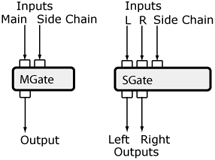| AudioMulch Help > Contraption Reference > Dynamics | Previous Next |
*NoiseGate
Allows loud sounds to pass while suppressing quiet ones (or vice-versa).

MNoiseGate and SNoiseGate are mono and stereo noise gates. A noise gate opens and closes, allowing louder sounds through while muting or reducing the gain of quieter sounds. *NoiseGate also provides a “duck” mode which attenuates loud sounds while leaving quieter sounds unchanged. Parameters are provided that determine when the gate opens and closes, how much gain reduction is applied when the gate is closed, and how fast the gate opens and closes.
The right-most input is a side chain input. When connected, this input is used to control the opening and closing of the gate. This can be used to create rhythmic gating effects where one sound is gated according to the rhythm of the sound connected to the side chain input.
 |
See the Adjusting Contraption Properties section for information about using sliders, knobs, presets etc. |
Related Contraptions
Parameters

|
Bypass |
When enabled, passes the unprocessed input through to the output. |
|
Mode |
Determines whether the gate opens for loud sounds (Gate mode) or for quiet sounds (Duck mode). In Gate mode, the gate opens for loud sounds (those above the threshold) and closes (attenuates) for quiet sounds (those below the threshold). In Duck mode, the contraption "ducks" loud sounds, attenuating them, while leaving quiet sounds unaffected. |
|
Input Gain (InputGain) |
Adjusts the gain of the input sound before being gated. |
|
Threshold |
Specifies the input level at which the gate opens and closes. The threshold parameter uses a range slider. The upper (maximum) value specifies the open threshold, while the lower (minimum) value specifies the close threshold. Although the gate will work with both thresholds set the same, using a lower close threshold reduces the chance of the gate "chattering" as the input level varies around the threshold. |
|
Range |
Specifies the amount of gain reduction applied when the gate is closed. When set to infinite (-oo) no signal is passed when the gate is closed. |
|
Attack (AttackTime) |
Adjusts the speed with which the gate opens when the threshold is exceeded. |
|
Hold (HoldTime) |
Adjusts the time the gate will stay open after the signal passes below the threshold. This can be useful for reducing chattering. |
|
Release (ReleaseTime) |
Adjusts the speed with which the gate closes. |
Instructions
Meters
NoiseGate provides a number of meters to allow you to monitor its operation.
The Key, Gain Reduction (GR) and Output (Out) meters use the same scale. It is a stretched scale which makes it easier to see the top 12dB, which is usually of most interest.
From left to right:
The Input meter (marked Key) displays the level of the incoming signal after Input Gain has been applied. The Threshold levels are indicated by arrows at the side of the meter: the left arrow indicates the open threshold, the right arrow indicates the close threshold. When something is connected to the side chain input, this meter will indicate the side chain level.
The Gain Reduction meter (GR) indicates how much gain reduction is being applied by the gate. The line at the right of the Gain Reduction meter indicates the amount of gain reduction applied when the gate is closed (determined by the Range parameter).
The Output meter (Out) shows the output level.
| Previous Next |
